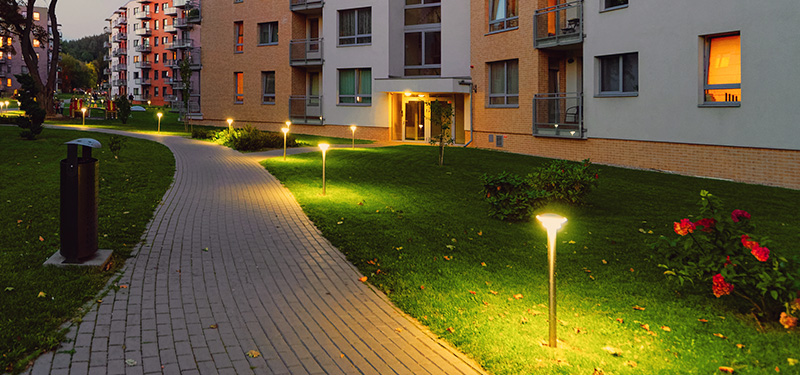Nov 27,2023
It has been said that of the five primary senses, humans derive the most information about the environment around them from their sense of sight, which undoubtedly plays a significant role in humans’ ability to function in their surroundings. Adequate lighting can improve safety and increase visibility at times where the role of sight is otherwise diminished by darkness.
Exterior lighting is one area where an ounce of prevention is worth a pound of cure, as it can eliminate a broad range of unsavory and, often times, avoidable liability claims.
In condominiums, proper exterior lighting plays a vital role in preventing injury to residents, employees and visitors by allowing distances to be judged and for the clear visual identification of persons or objects. Adequate illumination can also serve as a deterrent against potential intruders, reducing the risk of break-ins, theft of property, vandalism, and assault. With proper exterior lighting, a condominium association can deter unlawful intentions, reduce or eliminate hazards, and increase the sense of safety for those lawfully on the premises.
The Duty to Maintain a Safe Premises
Massachusetts courts “have recognized that ‘[a]s a general principle of tort law, every actor … has a duty to exercise reasonable care to avoid physical harm to others.’” Jupin v. Kask, 447 Mass. 141, 147 (2006) (citations omitted). An owner or possessor of land must act as a reasonable person in maintaining their property in a reasonably safe condition in view of all the circumstances, including the likelihood of injury to others, the seriousness of the injury, and the burden of avoiding the risk. Mounsey v. Ellard, 363 Mass. 693, 708 (1973) (citation omitted). Where retained control exists over part of a building or property—including common areas—then there is a duty to maintain those areas in a reasonably safe condition. Crowell v. McCaffrey, 377 Mass. 443, 450 (1979).
The duty that is owed to persons lawfully on a premises is limited to guarding against reasonably foreseeable risks of harm. Flood v. Southland Corp., 416 Mass. 62, 72-73 (1993). An owner or possessor of land is not a guarantor of the safety, and it is not obligated “to supply a place of maximum safety, but only one which would be safe to a person who exercises such minimum care as the circumstances reasonably indicate.” Toubiana v. Priestly, 402 Mass. 84, 88 (1988). The owner or possessor of land also must “use reasonable care to prevent injury … by third persons whether their acts are accidental, negligent, or intentional.” Carey v. New Yorker of Worcester, Inc., 355 Mass. 450, 452 (1969).
By way of recent example, in a decision that has widely been discussed (including by MBM, see: ‘A Cautionary Tale for Associations: A Condominium Association Bears a Duty to Exercise Reasonable Care for the Resident’s Safety in the Common Areas.’), in Field v. Highbridge Concierge, Inc., 1784 CV 02486-B (Mass. Super. Ct. July 5, 2022), Judge Christine Roach of the Massachusetts Superior Court found that a condominium trust had a duty of care to protect its residents from foreseeable crimes committed by third parties who enter the condominium through the common areas. The Court determined that the duty detailed herein above could reasonably be extended to the condominium trust, which was aware the condominium’s garage had previously been improperly accessed, and one of the victims had previously communicated to the trust that there was no locking mechanism on the interior stairwell doors. The risk of potential harm was determined to be foreseeable, and the condominium trust was not entitled to summary judgment.
Adequate Lighting to Improve Community Safety
Condominium associations are required to provide outdoor lighting for safety purposes. Poorly lit parking lots or walking paths can serve as a recipe for disaster when it comes to slip/trip and fall incidents, other avoidable injuries, and property damage, especially here in New England where snow and ice are a winter factor. From a safety standpoint, proper lighting is particularly important if there are any grade or material changes.
In the event of an emergency, a clear exit path to safety needs to be available. There is often diversity in the age and mobility of condominium residents and visitors, which may inform whether additional ingress and egress lighting should be installed. Paths of egress should include the building exit itself, but it may also be appropriate to light the way to safety. Having a properly illuminated means of egress and a well-illuminated pathway to safety at all times will assist in ensuring that people of all abilities can reach safety in the event of an emergency.
Adequate Lighting to Increase Security and Deter Crime
Lighting can also be used to address areas that may be at higher risk for criminal activity. As a practical matter, when a criminal or other critical event occurs outdoors at night, it is likely that it will be alleged that poor lighting was a factor. Poorly lit areas are more prone to crime, including vandalism, robbery, theft, and assault. It is easier to commit crime when the bad actor is not visible and has the element of surprise – a reason why thieves and assailants lurk in the shadows. A bad actor may not attempt a crime if they believe that there is a good chance that they will be seen or recorded. In this way, appropriate exterior lighting acts to effectively dissuade criminal activity.
Proper lighting is paramount to the safety of persons lawfully at the condominium, which lighting plan should be periodically evaluated to ensure that there are not shadowy walkways or ill-lit pathways in high traffic areas. Exterior lighting does not need to be bright and offensive to deter crime; appropriate lighting can be integrated into the landscape, delivering a message of deterrence to would-be criminals simply by keeping outdoor areas properly lit in a tasteful manner. Other measures, such as motion detection lights, can be utilized to trigger when activity occurs in an area (such as a loading dock, alternative entry point, or garage entrance) to dissuade trespassers from laying in wait or attempting crime in areas utilized less often.
For areas that are under video surveillance, it is important to ensure that there is appropriate outdoor lighting after dark in order that objects or individuals remain visible. Where cameras are going to be installed on community grounds, the amount of ambient light after dark must be taken into consideration. Although some cameras have the ability to see in very low light, it is appropriate to verify that sufficient lighting is always available to identify and record concerns.
Developing a Prioritized Plan to Ensure Adequate Lighting
An evaluation with respect to proper outdoor lighting for safety and security should be conducted by a condominium association periodically. An investment in proper lighting can increase security and substantially reduce the risk of liability, while also enhancing community ambiance. All good lighting plans would benefit from input from community members who are familiar with the site and its lighting concerns. A threshold step for condominium associations is to determine whether the municipality in which the community is located has policies governing site and exterior lighting. Other considerations include the selection of proper devices for illumination of building exterior and surrounding grounds to provide safe travel and enhance security, assessing whether professional assistance is required in terms of preparing a proper lighting survey, and developing a forward-looking plan for maintenance and infrastructure upgrades to increase safety and reduce liability.
A. Observe and Document Site Lighting Conditions
Every community has its own unique lighting needs. An inspection of the condominium should be conducted during twilight and nighttime hours to evaluate the adequacy of lighting and assess areas of concern. As a threshold matter, it should be determined whether existing exterior fixtures are operational. Long-term function, costs and aesthetics should be evaluated. Areas on the grounds that are observed to be dark or void of lighting should be noted, along with inconsistencies in lighting levels at critical locations, such as means of egress, walkways, and areas that are commonly traversed. Lighting priorities should be assigned, and improvements, if any, assessed and a plan for their implementation prepared.
An in-depth analysis of the existing conditions may help a condominium association identify how the current lighting is serving the community, and what improvements could be made. A professional survey may include custom design and the identification of recommended products. It may also include cost-saving suggestions, such as LED lighting and rebate opportunities, and a consultant may identify opportunities for the use of timers and motion detection for exterior lighting, which can result in additional savings in energy costs.
B. Upgrade to Durable Fixtures and “Green” Lighting Options
Outdoor lighting installations and maintenance can involve a substantial investment. Outdoor lighting should be carefully designed with regard to placement, intensity, timing, duration, and color. Energy use and the longevity of the lighting infrastructure are also important considerations. One important consideration for exterior fixtures is durability and exposure to the elements. Fixtures should be designed and approved and rated for harsh exterior environments, non-corrosive, and non-fading. As a cost saving measure, many condominium associations are looking toward “green” alternatives to save significant amounts of money on energy costs, such as upgrading lighting schemes to Light Emitting Diode (“LED”) lighting, which consumes less energy and requires little maintenance.
Conclusion
Part of creating a healthy condominium community environment is to ensure that there is adequate exterior lighting. This includes premises lighting to ensure safe travel, to deter crime, and create a warm and welcoming outdoor environment. A condominium association has a duty of care toward persons lawfully on the condominium premises to make decisions that reasonably protect onsite safety. The last thing that any condominium association wants to deal with is a costly lawsuit from someone who was injured in a poorly illuminated area. Whether the result of a slip and fall on a dimly lit walkway, or one vehicle striking another due to inadequate parking lot lighting, or because of an assault, resulting litigation can drag on for months or even years, and can result in high legal costs. Exterior lighting is one area where an ounce of prevention is worth a pound of cure, as it can eliminate a broad range of unsavory and, often times, avoidable liability claims.


